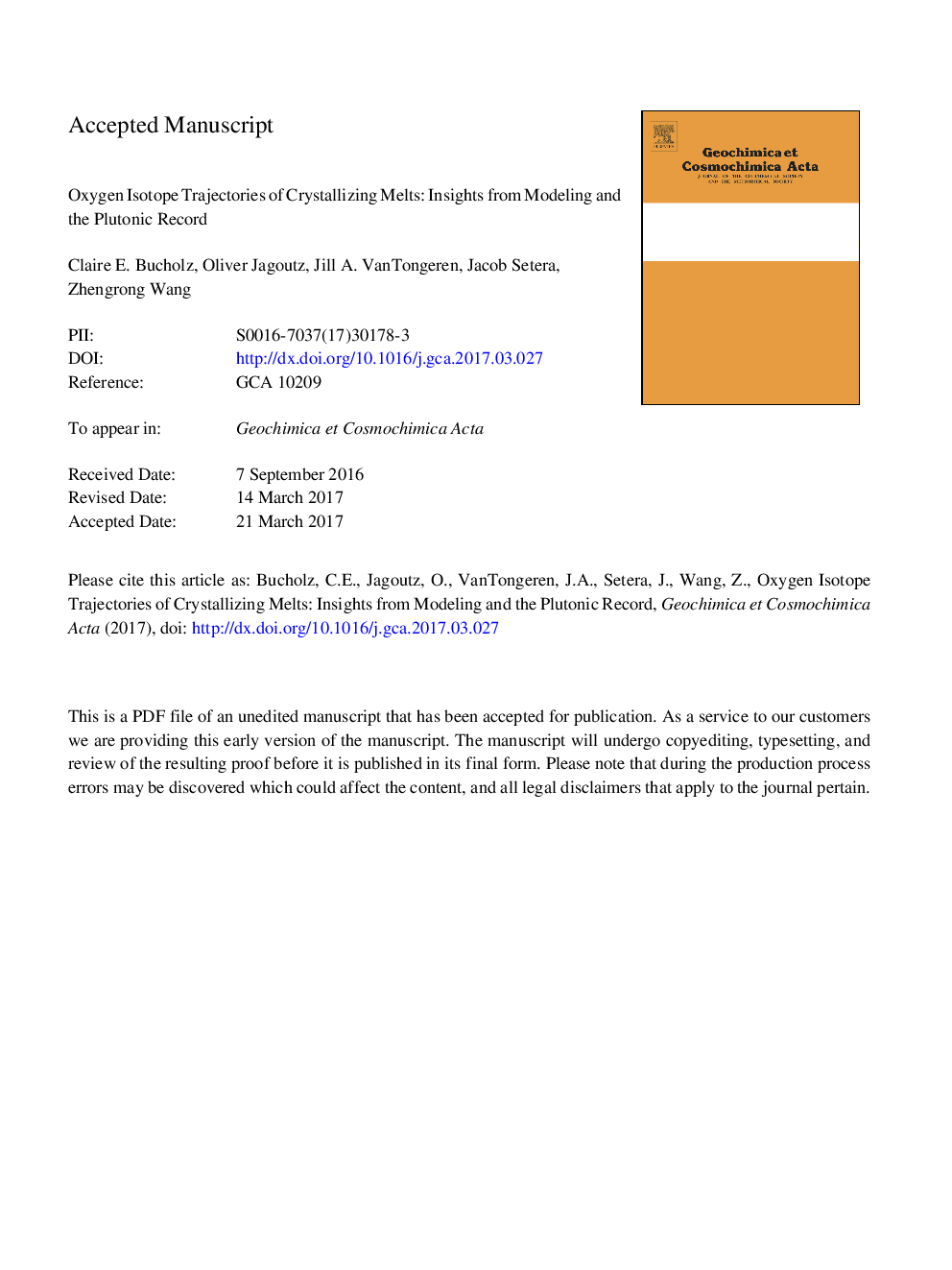| کد مقاله | کد نشریه | سال انتشار | مقاله انگلیسی | نسخه تمام متن |
|---|---|---|---|---|
| 5783524 | 1637950 | 2017 | 59 صفحه PDF | دانلود رایگان |
عنوان انگلیسی مقاله ISI
Oxygen isotope trajectories of crystallizing melts: Insights from modeling and the plutonic record
ترجمه فارسی عنوان
خطوط ایزوتوپی اکسیژن از ذوب بلورینگی: بینش از مدل سازی و رکورد تنوع
دانلود مقاله + سفارش ترجمه
دانلود مقاله ISI انگلیسی
رایگان برای ایرانیان
کلمات کلیدی
موضوعات مرتبط
مهندسی و علوم پایه
علوم زمین و سیارات
ژئوشیمی و پترولوژی
چکیده انگلیسی
Elevated oxygen isotope values in igneous rocks are often used to fingerprint supracrustal alteration or assimilation of material that once resided near the surface of the earth. The δ18O value of a melt, however, can also increase through closed-system fractional crystallization. In order to quantify the change in melt δ18O due to crystallization, we develop a detailed closed-system fractional crystallization mass balance model and apply it to six experimentally- and naturally-determined liquid lines of descent (LLDs), which cover nearly complete crystallization intervals (melt fractions of 1 to <0.1). The studied LLDs vary from anhydrous tholeiitic basalts to hydrous high-K and calc-alkaline basalts and are characterized by distinct melt temperature-SiO2 trajectories, as well as, crystallizing phase relationships. Our model results demonstrate that melt fraction-temperature-SiO2 relationships of crystallizing melts, which are strongly a function of magmatic water content, will control the specific δ18O path of a crystallizing melt. Hydrous melts, typical of subduction zones, undergo larger increases in δ18O during early stages of crystallization due to their lower magmatic temperatures, greater initial increases in SiO2 content, and high temperature stability of low δ18O phases, such as oxides, amphibole, and anorthitic plagioclase (versus albite). Conversely, relatively dry, tholeiitic melts only experience significant increases in δ18O at degrees of crystallization greater than 80%. Total calculated increases in melt δ18O of 1.0-1.5â° can be attributed to crystallization from â¼50 to 70 wt.% SiO2 for modeled closed-system crystallizing melt compositions. As an example application, we compare our closed system model results to oxygen isotope mineral data from two natural plutonic sequences, a relatively dry, tholeiitic sequence from the Upper and Upper Main Zones (UUMZ) of the Bushveld Complex (South Africa) and a high-K, hydrous sequence from the arc-related Dariv Igneous Complex (Mongolia). These two sequences were chosen as their major and trace element compositions appear to have been predominantly controlled by closed-system fractional crystallization and their LLDs have been modeled in detail. We calculated equilibrium melt δ18O values using the measured mineral δ18O values and calculated mineral-melt fractionation factors. Increases of 2-3â° and 1-1.5â° in the equilibrium melts are observed for the Dariv Igneous Complex and the UUMZ of the Bushveld Complex, respectively. Closed-system fractional crystallization model results reproduce the 1â° increase observed in the equilibrium melt δ18O for the Bushveld UUMZ, whereas for the Dariv Igneous Complex assimilation of high δ18O material is necessary to account for the increase in melt δ18O values. Assimilation of evolved supracrustal material is also confirmed with Sr and Nd isotope analyses of clinopyroxene from the sequence. Beginning with a range of mantle-derived basalt δ18O values of 5.7â° (“pristine” mantle) to â¼7.0â° (heavily subduction-influenced mantle), our model results demonstrated that high-silica melts (i.e. granites) with δ18O of up to 8.5â° can be produced through fractional crystallization alone. Lastly, we model the zircon-melt δ18O fractionations of different LLDs, emphasizing their dependence on the specific SiO2-T relationships of a given crystallizing melt. Wet, relatively cool granitic melts will have larger zircon-melt fractionations, potentially by â¼1.5â°, compared to hot, dry granites. Therefore, it is critical to constrain zircon-melt fractionations specific to a system of interest when using zircon δ18O values to calculate melt δ18O.
ناشر
Database: Elsevier - ScienceDirect (ساینس دایرکت)
Journal: Geochimica et Cosmochimica Acta - Volume 207, 15 June 2017, Pages 154-184
Journal: Geochimica et Cosmochimica Acta - Volume 207, 15 June 2017, Pages 154-184
نویسندگان
Claire E. Bucholz, Oliver Jagoutz, Jill A. VanTongeren, Jacob Setera, Zhengrong Wang,
